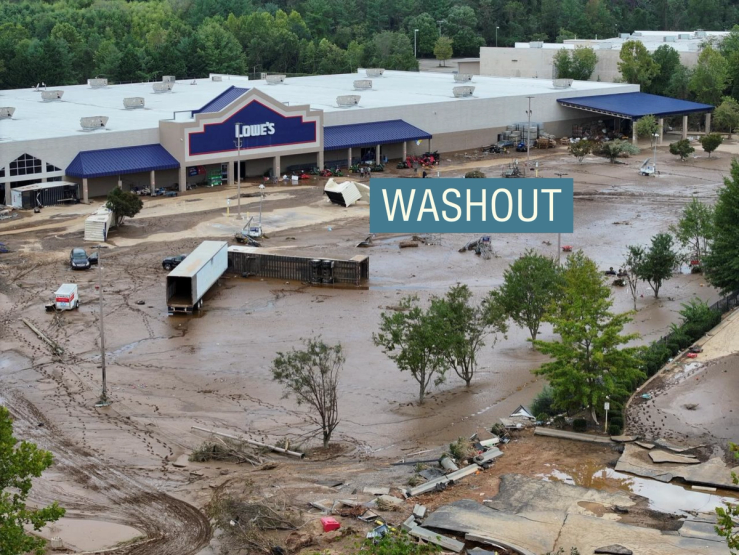The Scene
Renewable energy developers may be building solutions to the climate crisis, but as Hurricane Helene showed, they aren’t immune from its impacts.
When the storm hammered North Carolina last month, Ben Catt’s first thoughts were of his staff. His company, the solar farm developer Pine Gate Renewables, is based in Asheville: With power and cell networks down, it took Catt four days to contact all 100 of his employees, some of whose homes were destroyed completely. Catt’s own house was damaged by a fallen tree. Then he started receiving reports from his engineers: About 20 of the company’s solar fields, one-fifth of its fleet, were offline, and some sustained minor damage.
“So much electrical equipment is ground-mounted that if you get significant flooding, you can take out wide swaths of it,” he said.
All but one of those sites are back online as of this week, Catt said (the last is held up by broader damage to the nearby electric grid). But the fallout will hurt the company financially, and won’t be entirely covered by insurance.
“Our industry, at the scale we’re working at now, is very new,” he said. “All of the other industries that support us, in our supply chains and other services, still need to mature with us, and insurance is no exception.”
Tim’s view
As renewable energy developers find themselves on the front lines of climate change, they’ll need new strategies to stay resilient and solvent. The fossil fuel system has always been exposed to extreme weather; every year some offshore rigs and oil refineries in the US Gulf Coast are knocked out by hurricanes. But those are familiar challenges for operators and their insurers. Even though large-scale renewables are by now commonplace across the world, they are still treated by many insurers as a riskier asset class than conventional infrastructure, raising the costs of project development. Insurance executives have told me that they often feel left out of the renewables planning process until the last minute, which leaves them at a disadvantage in offering suggestions on siting, design, or other steps that could be taken to minimize risk and thereby lower premiums. Inadequate insurance also increases the time projects may remain offline following a disaster, costing the developer lost revenue from power sales.
Renewables developers, meanwhile, have traditionally been guided in where they site projects by resource availability (where is it sunniest or windiest), local demand, and government incentives. Exposure to climate risk for a proposed project is something that developers such as Pine Gate are just beginning to grapple with, Catt said. And it’s made more challenging by the fact that climate change is scrambling traditional extreme weather patterns; Asheville is the sort of inland location that would typically be seen as low risk for hurricane damage. And yet Helene revealed how exposed the whole climate tech ecosystem there is to extreme weather: In addition to Catt’s solar farms, the hurricane also damaged local quartz mines that supply the solar industry, a federal scientific facility that monitors global climate data, and the whole region’s electric grid.
Natural disasters have emerged as the number-one cause of insurance claims for the onshore renewables sector, a recent industry report found, with flooding and heavy rainfall the primary culprits. Insured losses will rise alongside the sector’s explosive growth. The key for renewables insurers — just as with the battered home insurance market — is to stay ahead of those changes, so they can calibrate premiums to reflect real risk but not be forced out of vulnerable markets altogether. Premiums are already starting to rise for solar projects in places where climate risk is evident, Catt said. In response, the renewables industry is developing more sophisticated climate-proofing technology, with panels that are hardened against hail and heavy winds. “As long as you’re being thoughtful about how you build these projects, you’re still going to have insurable assets,” he said.
The View From India
Some insurers are also devising products to help renewables developers cope with a different kind of weather problem: What if it’s less windy or sunny than the developer anticipated? In India, insurers are beginning to offer insurance against revenue volatility with policies that pay out if weather conditions are less favorable than predicted.
Know More
Hurricane Helene’s path and intensity were heavily influenced by man-made climate change, a study this week by World Weather Attribution, a group of leading climate scientists, concluded. Rainfall during the storm was at least 10% stronger than it would have been absent climate change, the study found, and the warm sea surface temperatures that propelled it were made 200-500 times more likely by climate change.
Room for Disagreement
Storms aren’t Catt’s biggest concern. That spot is still reserved for the grid connection queue and various permitting and bureaucratic bottlenecks, which remain a higher barrier to renewables deployment than any technological, supply chain, or financial issues.


